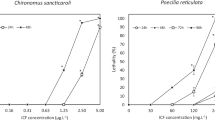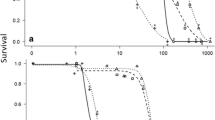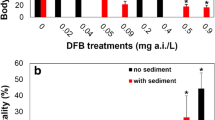Abstract
Several studies have indicated the presence of the neonicotinoid insecticide imidacloprid (IMI) in aquatic ecosystems in concentrations up to 320.0 µg L−1. In the present study, we evaluated the effects of the highest IMI concentration detected in surface water (320.0 µg L−1) on the survival of Chironomus sancticaroli, Daphnia similis, and Danio rerio in three different scenarios of water contamination. The enzymatic activities of glutathione S-transferase (GST), catalase (CAT), and ascorbate peroxidase (APX) in D. rerio also were determined. For this evaluation, we have simulated a lotic environment using an indoor system of artificial channels developed for the present study. In this system, three scenarios of contamination by IMI (320.0 µg L−1) were reproduced: one using reconstituted water (RW) and the other two using water samples collected in unpolluted (UW) and polluted (DW) areas of a river. The results indicated that the tested concentration was not able to cause mortality in D. similis and D. rerio in any proposed treatment (RW, UW, and DW). However, C. sancticaroli showed 100% of mortality in the presence of IMI in the three proposed treatments, demonstrating its potential to impact the community of aquatic nontarget insects negatively. Low IMI concentrations did not offer risks to D. rerio survival. However, we observed alterations in GST, CAT, and APX activities in treatments that used IMI and water with no evidence of pollution (i.e., RW and UW). These last results demonstrated that fish are more susceptible to the effects of IMI in unpolluted environments.



Similar content being viewed by others
Availability of Data and Material
The raw data are stored in a data repository at the University of São Paulo and can be made available upon request to the author (lucasgoncalvesqueiroz@gmail.com).
References
ABNT (2016) NBR 12713: aquatic ecotoxicology—acute toxicity—test with Daphnia spp (Cladocera, Crustacea), pp 1–27
Aebi H (1984) Catalase in vitro. Methods Enzymol 105:121–126
Alexander AC, Culp JM, Baird DJ, Cessna AJ (2016) Nutrient–insecticide interactions decouple density-dependent predation pressure in aquatic insects. Freshw Biol 61:2090–2101. https://doi.org/10.1111/fwb.12711
Anderson JC, Dubetz C, Palace VP (2015) Neonicotinoids in the Canadian aquatic environment: a literature review on current use products with a focus on fate, exposure, and biological effects. Sci Tot Environ 505:409–422. https://doi.org/10.1016/j.scitotenv.2014.09.090
Barnett BGR (1939) The use of sodium azide in the Winkler Method for the determination of dissolved oxygen. Sewage Work J 11:781–787
Bartlett AJ, Hedges AM, Intini KD et al (2019) Acute and chronic toxicity of neonicotinoid and butenolide insecticides to the freshwater amphipod, Hyalella azteca. Ecotoxicol Environ Saf 175:215–223. https://doi.org/10.1016/j.ecoenv.2019.03.038
Beketov MA, Liess M (2008) Potential of 11 pesticides to initiate downstream drift of stream macroinvertebrates. Arch Environ Contam Toxicol 55:247–253. https://doi.org/10.1007/s00244-007-9104-3
Böttger R, Feibicke M, Schaller J, Dudel G (2013) Effects of low-dosed imidacloprid pulses on the functional role of the caged amphipod Gammarus roeseli in stream mesocosms. Ecotoxicol Environ Saf 93:93–100. https://doi.org/10.1016/j.ecoenv.2013.04.006
Bradford MM (1976) A rapid and sensitive method for the quantitation of microgram quantities of protein utilizing the principle of protein-dye binding. Anal Biochem 72:248–254. https://doi.org/10.1016/j.sbi.2014.10.005
Chandran NN, Fojtova D, Blahova L et al (2018) Acute and (sub)chronic toxicity of the neonicotinoid imidacloprid on Chironomus riparius. Chemosphere 209:568–577. https://doi.org/10.1016/j.chemosphere.2018.06.102
Chará-Serna AM, Epele LB, Morrissey CA, Richardson JS (2019) Nutrients and sediment modify the impacts of a neonicotinoid insecticide on freshwater community structure and ecosystem functioning. Sci Tot Environ 692:1291–1303. https://doi.org/10.1016/J.SCITOTENV.2019.06.301
Chen Y, Yu K, Hassan M et al (2018) Occurrence, distribution and risk assessment of pesticides in a river-reservoir system. Ecotoxicol Environ Saf 166:320–327. https://doi.org/10.1016/j.ecoenv.2018.09.107
Coelho S, Oliveira R, Pereira S et al (2011) Assessing lethal and sub-lethal effects of trichlorfon on different trophic levels. Aquat Toxicol 103:191–198. https://doi.org/10.1016/j.aquatox.2011.03.003
Cunha DGF, Calijuri MdC, Lamparelli MC (2013) A trophic state index for tropical/subtropical reservoirs (TSI tsr). Ecol Eng 60:126–134. https://doi.org/10.1016/j.ecoleng.2013.07.058
Dantzger DD, Jonsson CM, Aoyama H (2018) Mixtures of diflubenzuron and p-chloroaniline changes the activities of enzymes biomarkers on tilapia fish (Oreochromis niloticus) in the presence and absence of soil. Ecotoxicol Environ Saf 148:367–376. https://doi.org/10.1016/j.ecoenv.2017.10.054
DeLeve LD, Kaplowitz N (1991) Glutathione metabolism and its role in hepatotoxicity. Pharmacol Ther 52:287–305. https://doi.org/10.1016/0163-7258(91)90029-L
do Amaral AMB, de Lima Costa Gomes J, Weimer GH et al (2018) Seasonal implications on toxicity biomarkers of Loricariichthys anus (Valenciennes, 1835) from a subtropical reservoir. Chemosphere 191:876–885. https://doi.org/10.1016/j.chemosphere.2017.10.114
Domenica A, Maria A, Stefania B et al (2017) Neonicotinoids and bees: the case of the European regulatory risk assessment. Sci Tot Environ 579:966–971. https://doi.org/10.1016/j.scitotenv.2016.10.158
Douglas MT, Chanter DO, Pell IB, Burney GM (1986) A proposal for the reduction of animal numbers required for the acute toxicity to fish test (LC50 determination). Aquat Toxicol 8:243–249. https://doi.org/10.1016/0166-445X(86)90076-7
EFSA (2018) Evaluation of the data on clothianidin, imidacloprid and thiamethoxam for the updated risk assessment to bees for seed treatments and granules in the EU
Egaas E, Sandvik M, Fjeld E et al (1999) Some effects of the fungicide propiconazole on cytochrome P450 and glutathione S-transferase in brown trout (Salmo trutta). Comp Biochem Physiol Part C Pharmacol Toxicol Endocrinol 122:337–344. https://doi.org/10.1016/S0742-8413(98)10133-0
Fenner K, Canonica S, Wackett LP, Elsner M (2013) Evaluating pesticide degradation in the environment: blind spots and emerging opportunities. Science 341:752–758. https://doi.org/10.1126/science.1236281
Fonseca AL, Rocha O (2004) Laboratory cultures of the native species Chironomus. Acta Limnol Bras 16:153–161
Ge W, Yan S, Wang J et al (2015) Oxidative stress and DNA damage induced by imidacloprid in zebrafish (Danio rerio). J Agric Food Chem 63:1856–1862. https://doi.org/10.1021/jf504895h
Gebicka L, Krych-Madej J (2019) The role of catalases in the prevention/promotion of oxidative stress. J Inorg Biochem 197:110699. https://doi.org/10.1016/j.jinorgbio.2019.110699
Giraudo M, Cottin G, Esperanza M et al (2017) Transcriptional and cellular effects of benzotriazole UV stabilizers UV-234 and UV-328 in the freshwater invertebrates Chlamydomonas reinhardtii and Daphnia magna. Environ Toxicol Chem 36:3333–3342. https://doi.org/10.1002/etc.3908
Gupta S, Gajbhiye V, Agnihotri N (2002) Leaching behaviour of imidacloprid formulations in soil. Bull Environ Contam Toxicol 68:502–508. https://doi.org/10.1007/s00128-001-0283-8
Habig WH, Pabst MJ, Jakoby WB (1974) Glutathione S-Transferases—the first enzymatic step in mercapturic acid formation. J Biol Chem 249:7130–7140
Hayasaka D, Korenaga T, Suzuki K et al (2012a) Cumulative ecological impacts of two successive annual treatments of imidacloprid and fipronil on aquatic communities of paddy mesocosms. Ecotoxicol Environ Saf 80:355–362. https://doi.org/10.1016/j.ecoenv.2012.04.004
Hayasaka D, Korenaga T, Suzuki K et al (2012b) Differences in susceptibility of five cladoceran species to two systemic insecticides, imidacloprid and fipronil. Ecotoxicology 21:421–427. https://doi.org/10.1007/s10646-011-0802-2
Hladik ML, Kolpin DW, Kuivila KM (2014) Widespread occurrence of neonicotinoid insecticides in streams in a high corn and soybean producing region, USA. Environ Pollut 193:189–196. https://doi.org/10.1016/j.envpol.2014.06.033
Hong X, Zhao X, Tian X et al (2018) Changes of hematological and biochemical parameters revealed genotoxicity and immunotoxicity of neonicotinoids on Chinese rare minnows (Gobiocypris rarus). Environ Pollut 233:862–871. https://doi.org/10.1016/J.ENVPOL.2017.12.036
Hong Y, Huang Y, Wu S et al (2020) Effects of imidacloprid on the oxidative stress, detoxification and gut microbiota of Chinese mitten crab, Eriocheir sinensis. Sci Tot Environ 729:138276. https://doi.org/10.1016/j.scitotenv.2020.138276
Hook SE, Gallagher EP, Batley GE (2014) The role of biomarkers in the assessment of aquatic ecosystem health. Integr Environ Assess Manag 10:327–341. https://doi.org/10.1002/ieam.1530
Husak VV, Mosiichuk NM, Maksymiv IV et al (2014) Histopathological and biochemical changes in goldfish kidney due to exposure to the herbicide Sencor may be related to induction of oxidative stress. Aquat Toxicol 155:181–189. https://doi.org/10.1016/j.aquatox.2014.06.020
Iturburu FG, Bertrand L, Mendieta JR et al (2018) An integrated biomarker response study explains more than the sum of the parts: oxidative stress in the fish Australoheros facetus exposed to imidacloprid. Ecol Indic 93:351–357. https://doi.org/10.1016/j.ecolind.2018.05.019
Jeschke P, Nauen R, Schindler M, Elbert A (2011) Overview of the status and global strategy for neonicotinoids. J Agric Food Chem 59:2897–2908. https://doi.org/10.1021/jf101303g
Jeschke P, Nauen R, Beck ME (2013) Nicotinic acetylcholine receptor agonists: a milestone for modern crop protection. Angew Chem Int Ed 52:9464–9485. https://doi.org/10.1002/anie.201302550
Kagabu S (2011) Discovery of imidacloprid and further developments from strategic molecular designs. J Agric Food Chem 59:2887–2896. https://doi.org/10.1021/jf101824y
Kobashi K, Harada T, Adachi Y et al (2017) Comparative ecotoxicity of imidacloprid and dinotefuran to aquatic insects in rice mesocosms. Ecotoxicol Environ Saf 138:122–129. https://doi.org/10.1016/j.ecoenv.2016.12.025
Kreuger J, Graaf S, Patring J, Adielsson S (2010) Pesticides in surface water in areas with open ground and greenhouse horticultural crops in Sweden 2008
La N, Lamers M, Bannwarth M et al (2014) Imidacloprid concentrations in paddy rice fields in northern Vietnam: measurement and probabilistic modeling. Paddy Water Environ 13:191–203. https://doi.org/10.1007/s10333-014-0420-8
Lamers M, Anyusheva M, La N et al (2011) Pesticide pollution in surface- and groundwater by paddy rice cultivation: a case study from Northern Vietnam. Clean: Soil, Air, Water 39:356–361. https://doi.org/10.1002/clen.201000268
Le Moal M, Gascuel-odoux C, Ménesguen A et al (2019) Eutrophication: a new wine in an old bottle? Sci Tot Environ 651:1–11. https://doi.org/10.1016/j.scitotenv.2018.09.139
Lu Z, Challis JK, Wong CS (2015) Quantum yields for direct photolysis of neonicotinoid insecticides in water: implications for exposure to nontarget aquatic organisms. Environ Sci Technol Lett 2:188–192. https://doi.org/10.1021/acs.estlett.5b00136
Lushchak OV, Kubrak OI, Storey JM et al (2009) Low toxic herbicide Roundup induces mild oxidative stress in goldfish tissues. Chemosphere 76:932–937. https://doi.org/10.1016/j.chemosphere.2009.04.045
Matsuda K, Buckingham SD, Kleier D et al (2001) Neonicotinoids: insecticides acting on insect nicotinic acetylcholine receptors. Trends Pharmacol Sci 22:573–580. https://doi.org/10.1016/S0165-6147(00)01820-4
Milošević D, Stojanović K, Djurdjević A et al (2018) The response of chironomid taxonomy- and functional trait-based metrics to fish farm effluent pollution in lotic systems. Environ Pollut 242:1058–1066. https://doi.org/10.1016/j.envpol.2018.07.100
Mor J-R, Dolédec S, Acuña V et al (2019) Invertebrate community responses to urban wastewater effluent pollution under different hydro-morphological conditions. Environ Pollut 252:483–492. https://doi.org/10.1016/J.ENVPOL.2019.05.114
Morrissey CA, Mineau P, Devries JH et al (2015) Neonicotinoid contamination of global surface waters and associated risk to aquatic invertebrates: a review. Environ Int 74:291–303. https://doi.org/10.1016/j.envint.2014.10.024
Nakano Y, Asada K (1981) Hydrogen peroxide is scavenged by ascorbate-specific peroxidase in spinach chloroplasts. Plant Cell Physiol 22:867–880
Narra MR, Rajender K, Reddy RR et al (2017) Insecticides induced stress response and recuperation in fish: biomarkers in blood and tissues related to oxidative damage. Chemosphere 168:350–357. https://doi.org/10.1016/J.CHEMOSPHERE.2016.10.066
Pestana JLT, Alexander AC, Culp JM et al (2009) Structural and functional responses of benthic invertebrates to imidacloprid in outdoor stream mesocosms. Environ Pollut 157:2328–2334. https://doi.org/10.1016/j.envpol.2009.03.027
Pisa LW, Belzunces LP, Bonmatin JM et al (2015) Effects of neonicotinoids and fipronil on non-target invertebrates. Environ Sci Pollut Res 22:68–102. https://doi.org/10.1007/s11356-014-3471-x
Qi S, Wang D, Zhu L et al (2018) Neonicotinoid insecticides imidacloprid, guadipyr, and cycloxaprid induce acute oxidative stress in Daphnia magna. Ecotoxicol Environ Saf 148:352–358. https://doi.org/10.1016/j.ecoenv.2017.10.042
Raby M, Nowierski M, Perlov D et al (2018) Acute toxicity of 6 neonicotinoid insecticides to freshwater invertebrates. Environ Toxicol Chem 37:1430–1445. https://doi.org/10.1002/etc.4088
Raby M, Zhao X, Hao C et al (2018) Relative chronic sensitivity of neonicotinoid insecticides to Ceriodaphnia dubia and Daphnia magna. Ecotoxicol Environ Saf 163:238–244. https://doi.org/10.1016/j.ecoenv.2018.07.086
Rico A, Arenas-Sánchez A, Pasqualini J et al (2018) Effects of imidacloprid and a neonicotinoid mixture on aquatic invertebrate communities under Mediterranean conditions. Aquat Toxicol 204:130–143. https://doi.org/10.1016/j.aquatox.2018.09.004
Sellaththurai S, Priyathilaka TT, Lee J (2019) Molecular cloning, characterization, and expression level analysis of a marine teleost homolog of catalase from big belly seahorse (Hippocampus abdominalis). Fish Shellfish Immunol 89:647–659. https://doi.org/10.1016/j.fsi.2019.03.064
Semchyshyn HM, Lozinska LM (2012) Fructose protects baker’s yeast against peroxide stress: potential role of catalase and superoxide dismutase. FEMS Yeast Res 12:761–773. https://doi.org/10.1111/j.1567-1364.2012.00826.x
Shan Y, Yan S, Hong X et al (2020) Effect of imidacloprid on the behavior, antioxidant system, multixenobiotic resistance, and histopathology of Asian freshwater clams (Corbicula fluminea). Aquat Toxicol 218:105333. https://doi.org/10.1016/j.aquatox.2019.105333
Silva MSGM, Marigo ALS, Viveiros W, Kuhlmann ML (2019) Frequency of mentum deformity in Chironomus sancticaroli (Diptera: Chironomidae) in a laboratory culture. Rev Ambient e Agua 14:1–8. https://doi.org/10.4136/1980-993X
Simon-Delso N, Amaral-Rogers V, Belzunces LP et al (2015) Systemic insecticides (Neonicotinoids and fipronil): trends, uses, mode of action and metabolites. Environ Sci Pollut Res 22:5–34. https://doi.org/10.1007/s11356-014-3470-y
Sinha AK, AbdElgawad H, Zinta G et al (2015) Nutritional status as the key modulator of antioxidant responses induced by high environmental ammonia and salinity stress in European sea bass (Dicentrarchus labrax). PLoS ONE 10:1–29. https://doi.org/10.1371/journal.pone.0135091
Slaninova A, Smutna M, Modra H, Svobodova Z (2009) A review: oxidative stress in fish induced by pesticides. Neuroendocrinol Lett 30:2–12
Stara A, Bellinvia R, Velisek J et al (2019) Acute exposure of common yabby (Cherax destructor) to the neonicotinoid pesticide. Sci Tot Environ 665:718–723. https://doi.org/10.1016/j.scitotenv.2019.02.202
Starner K, Goh KS (2012) Detections of the neonicotinoid insecticide imidacloprid in surface waters of three agricultural regions of California, USA, 2010–2011. Bull Environ Contam Toxicol 88:316–321. https://doi.org/10.1007/s00128-011-0515-5
Stoughton SJ, Liber K, Culp J, Cessna A (2008) Acute and chronic toxicity of imidacloprid to the aquatic invertebrates Chironomus tentans and Hyalella azteca under constant- and pulse-exposure conditions. Arch Environ Contam Toxicol 54:662–673. https://doi.org/10.1007/s00244-007-9073-6
Sumon KA, Ritika AK, Peeters ETHM et al (2018) Effects of imidacloprid on the ecology of sub-tropical freshwater microcosms. Environ Pollut 236:432–441. https://doi.org/10.1016/j.envpol.2018.01.102
Tišler T, Jemec A, Mozetič B, Trebše P (2009) Hazard identification of imidacloprid to aquatic environment. Chemosphere 76:907–914. https://doi.org/10.1016/j.chemosphere.2009.05.002
Topal A, Alak G, Ozkaraca M et al (2017) Neurotoxic responses in brain tissues of rainbow trout exposed to imidacloprid pesticide: assessment of 8-hydroxy-2-deoxyguanosine activity, oxidative stress and acetylcholinesterase activity. Chemosphere 175:186–191. https://doi.org/10.1016/j.chemosphere.2017.02.047
Uguz C, Iscan M, Ergüven A et al (2003) The bioaccumulation of nonyphenol and its adverse effect on the liver of rainbow trout (Onchorynchus mykiss). Environ Res 92:262–270. https://doi.org/10.1016/S0013-9351(03)00033-1
Van der Oost R, Beyer J, Vermeulen NPE (2003) Fish bioaccumulation and biomarkers in environmental risk assessment: a review. Environ Toxicol Pharmacol 13:57–149. https://doi.org/10.1016/S1382-6689(02)00126-6
Van Dijk TC, Van Staalduinen MA, Van Der Sluijs JP (2013) Macro-invertebrate decline in surface water polluted with imidacloprid. PLoS ONE. https://doi.org/10.1371/journal.pone.0089837
Vieira CED, Pérez MR, Acayaba RD et al (2018) DNA damage and oxidative stress induced by imidacloprid exposure in different tissues of the neotropical fish Prochilodus lineatus. Chemosphere 195:125–134. https://doi.org/10.1016/J.CHEMOSPHERE.2017.12.077
Vieira M, Soares AMVM, Nunes B (2019) Biomarker-based assessment of the toxicity of the antifungal clotrimazol to the microcrustacean Daphnia magna. Environ Toxicol Pharmacol 71:103210. https://doi.org/10.1016/j.etap.2019.103210
Vignet C, Cappello T, Fu Q et al (2019) Imidacloprid induces adverse effects on fish early life stages that are more severe in Japanese medaka (Oryzias latipes) than in zebrafish (Danio rerio). Chemosphere 225:470–478. https://doi.org/10.1016/j.chemosphere.2019.03.002
Wang Y, Han Y, Xu P et al (2018) The metabolism distribution and effect of imidacloprid in chinese lizards (Eremias argus) following oral exposure. Ecotoxicol Environ Saf 165:476–483. https://doi.org/10.1016/j.ecoenv.2018.09.036
Wood TJ, Goulson D (2017) The environmental risks of neonicotinoid pesticides: a review of the evidence post 2013. Environ Sci Pollut Res 24:17285–17325. https://doi.org/10.1007/s11356-017-9240-x
Wu S, Li X, Liu X et al (2018) Joint toxic effects of triazophos and imidacloprid on zebrafish (Danio rerio). Environ Pollut 235:470–481. https://doi.org/10.1016/j.envpol.2017.12.120
Xia X, Xia X, Huo W et al (2016) Toxic effects of imidacloprid on adult loach (Misgurnus anguillicaudatus). Environ Toxicol Pharmacol 45:132–139. https://doi.org/10.1016/J.ETAP.2016.05.030
Xing Z, Chow L, Rees H et al (2013) Influences of sampling methodologies on pesticide-residue detection in stream water. Arch Environ Contam Toxicol 64:208–218. https://doi.org/10.1007/s00244-012-9833-9
Yadav IC, Watanabe H (2018) Soil erosion and transport of Imidacloprid and Clothianidin in the upland field under simulated rainfall condition. Sci Tot Environ 640–641:1354–1364. https://doi.org/10.1016/j.scitotenv.2018.06.008
Yamamoto I, Casida JE (1999) Nicotinoid insecticides and the nicotinic acetylcholine receptor, 1st edn. Springer, Berlin
Zhang H, Davies KJA, Forman HJ (2015) Oxidative stress response and Nrf2 signaling in aging. Free Radic Biol Med 88:314–336. https://doi.org/10.1016/j.freeradbiomed.2015.05.036
Funding
This study was financed in part by the Coordenação de Aperfeiçoamento de Pessoal de Nível Superior—Brasil (CAPES)—Finance Code 001.
Author information
Authors and Affiliations
Contributions
LGQ conceived the presented idea, designed and performed ecotoxicological experiments, created and built the indoor system of artificial channels, analyzed the data, elaborated tables, and figures and wrote the article; CCAP performed the activity enzymatic experiments and helped in the analysis of these results; ECA, FAD, and EP performed the chromatographic analysis and helped in the analysis of these results; FTS responsible for Laboratory of Ecotoxicology; TCBP supervised the project.
Corresponding author
Ethics declarations
Conflict of interest
The opinions presented in the present study are those of the authors. There was no financial support that could have influenced its outcome, and there are no known conflicts of interest related to this publication. All named authors approved the manuscript and the order of authors listed.
Ethics Approval
Experimental procedures were previously approved by the Ethics Committee on Animals Use of the Biosciences Institute of the University of São Paulo (CEUA no. 310/2018).
Electronic supplementary material
Below is the link to the electronic supplementary material.
Rights and permissions
About this article
Cite this article
Queiroz, L.G., do Prado, C.C.A., de Almeida, É.C. et al. Responses of Aquatic Nontarget Organisms in Experiments Simulating a Scenario of Contamination by Imidacloprid in a Freshwater Environment. Arch Environ Contam Toxicol 80, 437–449 (2021). https://doi.org/10.1007/s00244-020-00782-3
Received:
Accepted:
Published:
Issue Date:
DOI: https://doi.org/10.1007/s00244-020-00782-3




